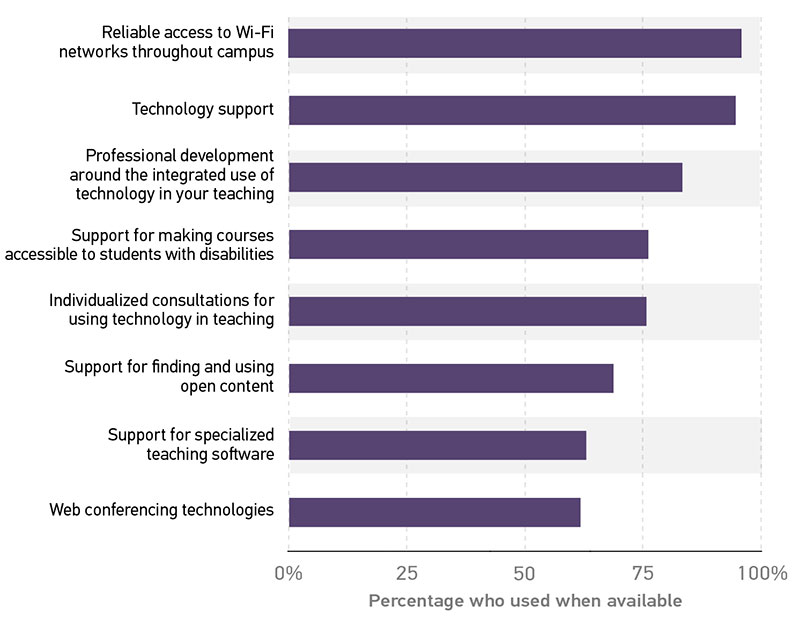Technology Support Services Can Benefit Faculty and Students
If community college faculty increase their technology skills through professional development and training, it not only benefits them but can also benefit their students. For example, videoconferencing has been shown to be an effective means of engaging students in online environments.1 Similarly, faculty skill in finding and using open educational resources (OER) can help offset the costs of course materials for students. These expenses come into sharp relief when we consider that more than a third (37%) of all community college students come from households that make less than $20,000 annually and that the average cost of course materials was $415 in the 2018–19 academic year.2 Moreover, because about 20% of community college students have a disability, faculty knowledge of accessible technologies and the ability to implement them successfully are crucial for equitable access for these students.3 But are faculty taking advantage of these technologies and accessing support for them when needed (see figure 2)?

We do know that faculty who use the support that is available for these services find it valuable. For example, a majority (65%) rated their institution's support for making courses accessible to students with disabilities good or excellent. However, around a quarter of CC faculty did not use this support when it was available on their campus. Although two-year faculty take advantage of support for making courses accessible to students with disabilities at higher rates than their colleagues at four-year institutions,4 leaders of community colleges should nevertheless increase communication about the availability of these support services and assist faculty in implementing these services for their students. Research suggests that there are gaps in institutional staff's knowledge of how information and communication technologies can be used for students with disabilities.5 Increasing training opportunities and faculty satisfaction with that training are key to expanding support to aid these students.
Additionally, we found that a little more than half (54%) of faculty valued support for finding and using OER, but a third (31%) did not use these services when available. However, faculty who reported they were satisfied with OER training reported they would not return to using traditional course materials.6 Institutions should increase efforts to communicate that support for OER is available and improve the quality of these services, since one of the largest obstacles to adopting OER is lack of faculty awareness of these resources.7 Finally, 38% hadn't used support for web conferencing technology when available, but the 60% who had used it rated it good or excellent. Web conferencing can be particularly valuable for students in online classes because students value interaction with faculty in virtual classrooms. Video technology can facilitate engagement in collaborative activities—for example, providing immediate feedback on presentations.8 Institutional leaders should increase faculty awareness of available training and support for these services. And increasing participation in and satisfaction with these services will empower faculty to engage with community college students who need the most support to meet their educational goals.
Notes
-
D. P. Rudd, "The Value of Video in Online Instruction," Journal of Instructional Pedagogies (2014): 13.
↩︎ -
Community College FAQs, Community College Research Center, Teachers College, Columbia University; and Nick Hazelrigg, "Textbook Spending Continues Slow Decline," Inside Higher Ed, July 25, 2019.
↩︎ -
Catherine Fichten, Dorit Olenik-Shemesh, Jennison Asuncion, Mary Jorgensen, and Chetz Colwell, "Higher Education, Information and Communication Technologies and Students with Disabilities: An Overview of the Current Situation," in Improving Accessible Digital Practices in Higher Education, ed. J. Seale (Palgrave Pivot, Cham., 2020), 21–44.
↩︎ -
Joseph D. Galanek and Dana C. Gierdowski, ECAR Study of Faculty and Information Technology, 2019, research report (Louisville, CO: ECAR, December 2019).
↩︎ -
Fichten et al., "Higher Education, Information and Communication Technologies."
↩︎ -
Rebecca Griffiths, Jessica Mislevy, Sam Wang, Linda Shear, Alexandra Ball, and Donna Desrochers, "OER at Scale: The Academic and Economic Outcomes of Achieving the Dream's OER Degree Initiative," (Menlo Park, CA: SRI International, 2020).
↩︎ -
Fred Lokken, Trends in eLearning: Tracking the Impact of eLearning at Community Colleges (Instructional Technology Council, 2016).
↩︎ -
M'hammed Abdous and Cherng-Jyh Yen, "A Predictive Study of Learner Satisfaction and Outcomes in Face-to-Face, Satellite Broadcast, and Live Video-Streaming Learning Environments," The Internet and Higher Education 13, no. 4, (2010): 248–57.
↩︎